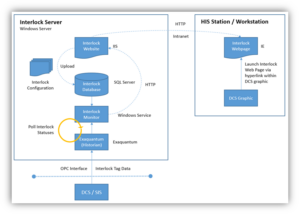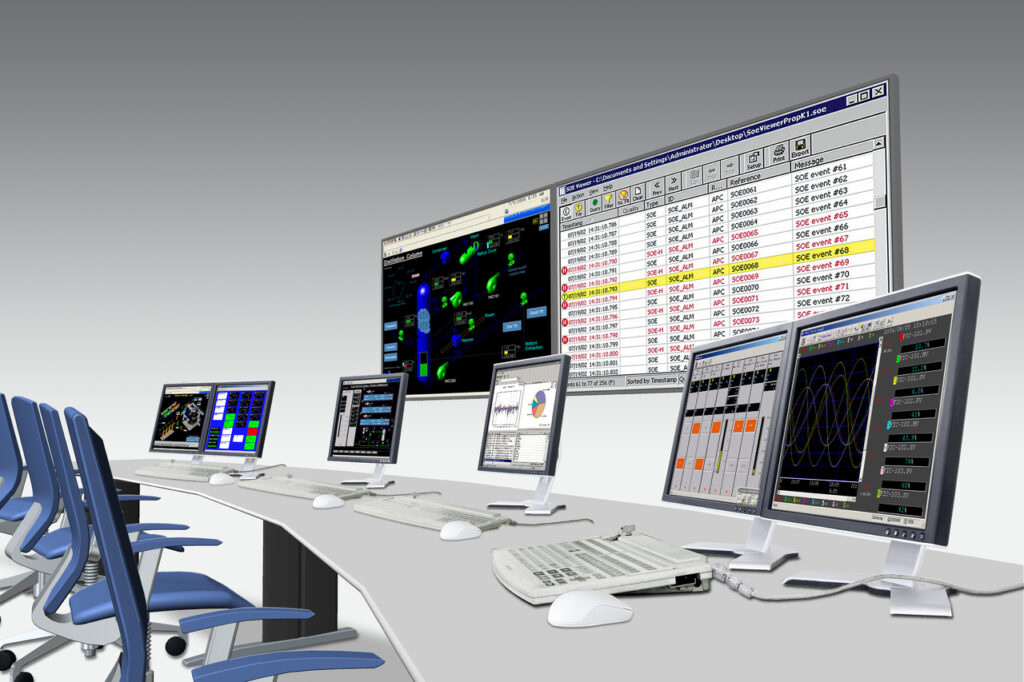Determining interlocks
Interlocks are designed to produce an action, due to a combination of events that may prevent undesired situations for safety of equipment and plant personel. For process industries, the key requirement is to have adequate information and visibility on what equipment is and what is not on interlock. During non-steady state operations including start-up, shutdown, maintenance, testing and troubleshooting, interlocks can trigger more frequently, requiring more attention and focus for operators. Plant conditions are changing rapidly, triggering interlocks on equipment and instrumentation that can prevent certain processes from starting or stopping. This elevates the level of risk to multiple instrumentation and equipment that has implications from a safety and quality standpoint, but also drives down operational efficiency.
When an interlock is triggered, operators within the control room are notified of such events. To remedy these conditions, reliable and accurate information relating to the causes of interlock conditions need to be accessed. Invisible or obscure interlock logic is an ongoing frustration for operators and users, especially during non-steady state operations during start-ups, process upsets and transitions that can impact plant production. (Follow this link to control systems of Yokogawa)
General comments from the control room are
- “We are ready to start Area X5, Unit 3. Are there any interlocks active for this area/unit?”
- “We are testing the initiators on Interlock IC10 and accidentally triggered Interlock IF30?”
- “Instrument technician is working on PT50, and I thought Valve X was the only device affected…”
- “Our batch is complete and we need to transfer out of Tank A, but Pump A10 won’t start….call the engineer and maintenance person in….”
Interlock information is usually stored in the form of customized graphics, which are derived from the cause and effect matrix, to aid the resolution of these ‘undesired’ conditions. These custom graphics are limited in terms of the in-built functionality and drill down capabilities to provide the right level of information for troubleshooting and problem resolution. Customized graphics are not easy to maintain and keep updated in line with operational conditions, which makes it difficult to resolve conditions quickly and efficiently, absorbing large amounts of resources.
Interlocks can cause disruption and delay to production processes, and information to address these issues requires a more dynamic approach to visualize interlock conditions. It is important that this can be easily maintained, updated and readily available to operators, maintenance and engineering teams. Any disruption can result in production slowdowns and stoppages that can adversely affect production efficiency and costs.
Dynamic Interlock Visualization
A better way of monitoring interlock conditions was required, one that would provide an active view of all interlock information via a single entry point for the entire plant. With direct access to interlock information from the Integrated Control and Safety System (ICSS) in the control room, this improves the interpretation and resolution with access to reliable and accurate interlock information. Yokogawa were able to provide a software solution to address the needs of the customer by developing a dynamic interlock visualization tool to enable interlock data to be monitored and analyzed, helping to resolve interlock conditions rapidly.
The interlock user interface provides a general display of the status of all interlocks across multiple plants for a full and comprehensive view of all interlocks. For rapid resolution of interlock conditions, operators are able to access interlock information directly from Human Machine Interface (HMI) screens in the control room that presents real time status capture from the ICSS. The same web based user interface is also available for users outside of the control room e.g. maintenance and engineering teams, with improved visibility of interlock status for all departments.
Easier Identification
The software provides a clear display of information, making it easy for users to navigate through the interlock data. With intuitive navigation and inbuilt logic in the web display, it easy for operators to drill down into the data for interlocks, actions and initiators to help with rapid resolution of interlock conditions. Within the web display, important equipment and areas can be visually highlighted for easier identification, so that operator attention is focused on the areas of high importance, helping to avoid slowdowns and stoppages in production.
This solution also replaces the need for specific custom graphics to be created, managed and maintained. All interlock information is available from the display screen with out-of-the-box functionality with drill down capabilities to navigate through the interlock hierarchy. This is a more reliable and robust approach that presents interlock information to help identify interlock causes and conditions and is integrated with the ICSS, providing more confidence in the information being presented to users.
This is an easy to use software tool with a simplified and user-friendly interface with configuration and management capabilities in a single stand-alone application that can be deployed across multiple plants.
Benefits
Improved plant operations through the rapid and reliable access to interlock data in a unified environment.
Reduced production delays with fast resolution of production delays and stoppages that relate to hard to find interlock dependencies. Users are able to quickly search and navigate through information that require investigations to have a better understanding and insight to resolve interlock conditions.
Effective end user assistance through the faster identification of problem areas to assist operational issue resolution.
HMI display simplification – Customized display graphics have a tremendous load on the system, by replacing the existing solution with a software solution it saves time and frees resources.
Reduction in preventable shutdowns through the increased visibility of shutdown risks when working on the ICSS or in the field. Planned work with the systems process or in the field is improved by helping to identify the potential risks of tripping or triggering interlocks.
Audit trail of all interlock changes to see clearly all changes made to interlocks with user defined areas for change management
Project Scope
This solution was developed in partnership with a large chemical business in the US at their corporate headquarters, one of the largest facilities of its type in North America. As part of a major modernization program, several major automation projects were identified which presented an opportunity to do things differently, and do things better. One of these projects included a review of how interlock monitoring was being managed and if there was an opportunity to do things differently. Previously, interlock monitoring was implemented by a custom solution developed in-house, which was limited in terms of the resource and knowledge isolation. This approach offered very little support moving forward; especially as IT systems are always changing with software updates and upgrades. It presented an opportunity to re-imagine a different approach to interlock monitoring, moving away from doing things in-house to work with Yokogawa on the automation side of the project for stability and support moving forward.
There were a number of key areas that were identified to improve interlock troubleshooting and visualization and to remedy the problems with the existing solution.
ICSS Engineering Tools
It was important that the solution considered the response time to investigate interlock conditions. It had to improve the resource efficiency and be more dependable and effective than the current solution.
Custom Interlock Displays
Custom interlock graphics are very costly to produce and require ‘ongoing’ maintenance to keep them updated. They are also limited in terms of their functionality and are static graphics that do not facilitate problem resolution.
Built-in functionality
Custom graphics have no in-built functionality and are limited, especially in terms of the drill down capabilities.
Implementation

Yokogawa’s interlock monitoring solution provides an intuitive display of interlock information that mirrors the interlock configuration on the ICCS. The interlock status signals from the ICCS can be used to update the information presented in the web user interface through an OPC DA connection. This enables tag data acquired through Exaquantum to be monitored and analyzed.
The interlock monitoring solution collects and presents tag data for interlocks, initiators, and actions and displays this data to users through a web user interface. The software connects to an instance of Exaquantum, and notifies the interlock monitor whenever a configured tag updates. This enables the web user interface to have access to live data from multiple plants and therefore display a clear status of all configured interlocks in the system.
Key Takeaways
Replaces customized solutions / interlock graphics
This solution replaces the need for specific interlock graphics to be created, managed and maintained which can significantly reduce engineering time and resources. The previous customized solution is no longer required, replaced with an intuitive web user interface that monitors all interlock data that can be deployed across single or multiple plants which is fully supported.
Integrates with ICSS HMI displays
Operators are able to quickly access interlock information directly from the ICCS in the control room, presenting real time status capture of interlock data to help maintain operations with integrated security via single sign-on.
Comprehensive view of interlocks
A single user interface provides a general display of the status of all interlocks across multiple plants for a full and comprehensive view of all interlocks.
Avoids production delays
By accessing interlock information rapidly with hierarchy drill down capabilities, it assists operators in the quick resolution of interlock conditions to reduce production delays and slowdowns especially during non-steady state operations.
Shortens project implementation times
Time can be reduce to implement projects or maintenance activities as interlock triggers and conditions are easier to identify and remedy.
Management of Change
This supports both large-scale and small-scale changes in the process for all interlocks, initiators and actions.
Reduces ICSS Configuration
ICSS interlock configuration is simplified which reduces the ICSS configuration lifecycle maintenance costs.
This article is also published here.





Good one. Well covered the benefits of dynamic interlock visualization.
We have faced several times the call especially in night shifts / late hour startup situations that let us know the interlock condition of PA or ID fan as it is not starting. As the custodian of control systems we need to check and inform the operation team what is causing not to start /stop. With this solution Control room personnel will be well equipped the to take the immediate action and then maintenance team can focus on other activities.